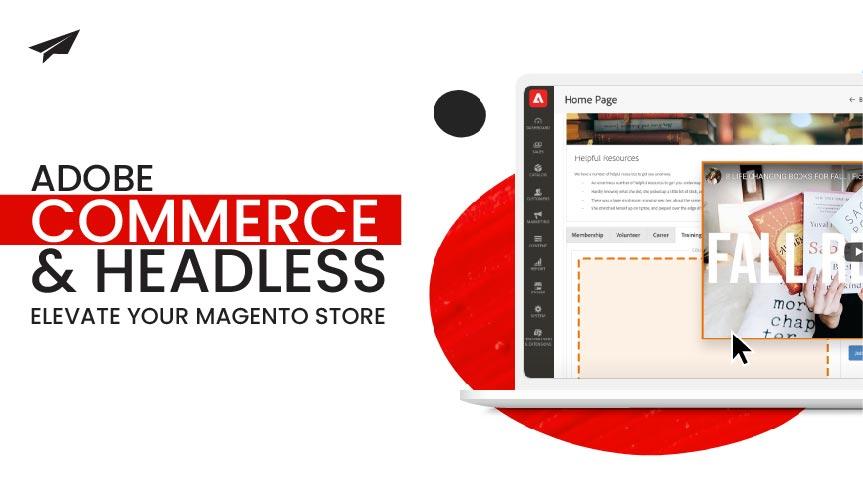Adobe Commerce and Headless: Elevate Your Magento Store
The power of the popular Adobe Commerce platform is something you must know, if you are running an online store on magento platforms. Magento hosting is one of the most commonly used eCommerce platforms globally, powering over 250,000 merchants worldwide. However, as technology evolves, merchants must keep up with the changing eCommerce landscape. One way to attain this is by incorporating Adobe Commerce and Headless ecommerce platform into your Magento store.
In this blog article, we will talk about the power of Adobe Commerce Cloud, Omnichannel Experience and Headless architecture and how they can help elevate your Magento store to the next level. Let’s dive in!

What is Adobe Commerce Cloud?
Adobe Commerce Cloud, previously known as Magento Commerce, is an all-in-one eCommerce platform that combines content and commerce to create seamless customer experiences. Adobe Commerce is a cloud-based platform that allows merchants to customize their eCommerce store to meet their unique needs. In addition, you can access many features with Adobe Commerce, including AI-powered product recommendations, real-time inventory management, and much more.
Adobe Commerce offers a range of support and training resources to help businesses get the most out of the platform. This includes access to a dedicated support team, online training resources, and a global community of users.
Adobe Commerce Cloud is a powerful eCommerce platform that offers businesses a range of features and tools to create a fully customized online store. Its scalability, integration with other Adobe products, and headless commerce make it a popular choice among businesses looking to create a seamless and personalized online shopping experience for their customers.
Why Omnichannel Experience Best For Magento:
Adobe enables merchants to provide customers with an omnichannel experience by allowing them to shop online, in-store, or on their mobile devices. This approach will enable merchants to meet their customers where they are and provide them with a seamless shopping experience.
There are several benefits to providing an omnichannel experience for customers. First and foremost, it can lead to increased customer satisfaction and loyalty, as customers appreciate the convenience and ease of use of being able to interact with a brand on their preferred channel. Additionally, an omnichannel approach can lead to increased sales and revenue, as customers are more likely to make a purchase if they can seamlessly move through the purchasing journey across multiple channels.
Providing an effective omnichannel can be a key differentiator for businesses looking to stand out in a crowded marketplace and build strong, lasting relationships with their customers.
What is Headless Architecture?
Headless architecture is an approach to eCommerce that separates the front-end and back-end of an eCommerce platform. In a traditional eCommerce platform, the front-end and back-end are tightly integrated, making it challenging to customize the user interface. The architecture of headless splits up the front-end and back-end, allowing merchants to customize the user interface without affecting the back end. Some of the advantages are:
Flexibility:
Headless allows merchants to customize their eCommerce platform to meet their unique needs. This approach enables merchants to create a unique user experience that reflects their brand.
Scalability:
It enables merchants to scale their eCommerce platform to meet the demands of their growing business. With headless, merchants can add new functionality and features to their eCommerce platform without affecting the back end.
Performance:
It can significantly improve an eCommerce platform’s performance by reducing the server’s load. With headless architecture, the front end is responsible for rendering the user interface, while the back end is responsible for managing the eCommerce platform’s data.
Headless ecommerce platform
As eCommerce continues to evolve, businesses are looking for new ways to provide their customers with a personalized and flexible shopping experience. One way to achieve this is by using a headless eCommerce platform. Unlike traditional eCommerce platforms, headless platforms separate the front-end and back-end of an eCommerce store. This separation allows for greater flexibility in design and functionality, as businesses can customize the front end of their eCommerce store to meet their specific needs. However, while headless eCommerce platforms offer many advantages, they also come with challenges that businesses must be aware of. A headless e-commerce platform with headless architecture, Adobe eCommerce, and Magento offers several advantages that can help merchants elevate their eCommerce store.
Real-Time Inventory Management:
Adobe and Magento hosting offers real-time inventory management, which enables merchants to track inventory levels and restock products as needed. This feature helps merchants avoid stockouts and ensures they always have the products their customers seek. While on the other hand, Shopify is a subscription-based platform, meaning merchants must pay a monthly fee to use it. The costs can add up quickly when combined with headless and Adobe Commerce. In addition, merchants may also need to pay for additional apps and integrations, which can further increase the price.
Customizable User Interface:
With headless, merchants can customize the user interface of their eCommerce store to meet their specific business needs. This feature enables merchants to create a unique and personalized shopping experience for their customers. While Shopify offers some customization, more is needed for businesses that require highly customized eCommerce stores.
Scalability:
Adobe Commerce Cloud and Magento are highly scalable, which means they can handle significant traffic and sales volume. This feature is essential for merchants looking to grow their business and expand their customer base. Others, like Shopify, are only suitable for companies requiring a low level of scalability.
Community Support:
Magento’s large and active community of developers, designers, and merchants contribute to its development and support. This community support ensures merchants have access to a wide range of resources and tools to help them create a successful eCommerce store. For example, Shopify offers some level of integration with other platforms and apps, but the options may be limited, which differs from this case.
Conclusion:
In conclusion, Adobe Commerce and headless are powerful tools that can help elevate your Magento store and omnichannel experience to the next level. By combining these tools, merchants can create a unique eCommerce experience that meets their customers’ needs. With features like AI-powered product recommendations, real-time inventory management, and the flexibility to customize the user interface, Adobe and headless ecommerce can help merchants stay ahead of the competition.
If you’re considering implementing Adobe Commerce and headless ecommerce platform on your magento platforms, working with a partner with experience implementing these technologies is essential. Hiring a Magento developer from TekGlide can help you leverage the power of Adobe Commerce and headless to create a seamless shopping experience for customers.






